
Herring are forage fish, mostly belonging to the family of Clupeidae.
The wolf herrings are a family (Chirocentridae) of two marine species of ray-finned fish related to the herrings.

The Elopidae are a family of ray-finned fish containing a single living genus Elops. They are commonly known as ladyfish, skipjacks, jack-rashes, or tenpounders.
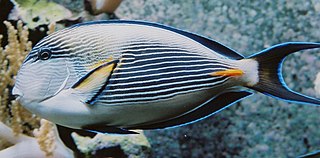
The sohal surgeonfish or sohal tang, is a species of marine ray-finned fish belonging to the family Acanthuridae, which includes the surgeonfishes, unicornfishes and tangs. This fish is found in the northwestern Indian Ocean.

The orange-spotted trevally, Carangoides bajad is a species of inshore marine fish in the jack family, Carangidae. The species is fairly common in tropical to subtropical waters of the Indo-Pacific, ranging from Madagascar in the west to Japan in the east, typically inhabiting inshore reefs. The species has characteristic orange-yellow spots on its sides, although counts of fin rays and scutes are needed to distinguish it from related species with similar colouring. Orange-spotted trevallies are powerful predators, taking a variety of small fish, nekton, and crustaceans, and reach sexual maturity around 25 cm long. It is a moderately large fish, reaching a maximum known length of 55 cm. The species is occasionally taken by fishermen throughout its range, and is generally considered to be bycatch. The exception to this is in the southern Persian Gulf, where it makes up a large proportion of the fishery.

The common bluestripe snapper, bluestripe snapper, bluebanded snapper, bluestripe sea perch, fourline snapper, blue-line snapper or moonlighter, is a species of snapper belonging to the family Lutjanidae. It is native to the Indian Ocean from the coast of Africa and the Red Sea to the central Pacific Ocean. It is commercially important and sought as a game fish. It can also be found in the aquarium trade.
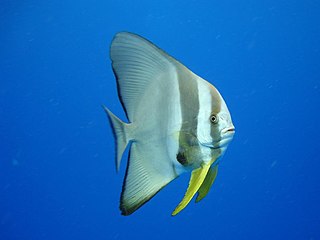
Platax teira, also known as the teira batfish, longfin batfish, longfin spadefish, or round faced batfish is a species of marine ray-finned fish belonging to the family Ephippidae, the spadefishes and batfishes. This species is found in the Indo-West Pacific.
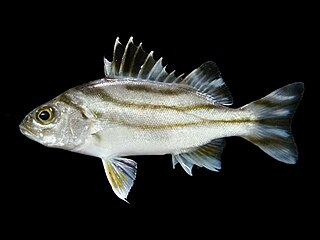
Terapon jarbua, the jarbua terapon, crescent grunter, crescent banded grunter, crescent perch, spiky trumpeter, thornfish or tiger perch, is a species of ray-finned fish, a grunter of the family Terapontidae. It occurs in the Indo-Pacific. it is an important commercial species within its range and is sometimes found in the aquarium trade where it is known as "target fish" for the pattern visible from above.

The reticulate whipray or honeycomb stingray is a species of stingray in the family Dasyatidae. It inhabits coastal waters in the western Indian Ocean including the Red Sea, Natal and the Arabian Sea; also a Lessepsian transmigrant in the eastern Mediterranean. A large species reaching 2 m (6.6 ft) in width, the reticulate whipray has a diamond-shaped pectoral fin disc and an extremely long tail without fin folds. Both its common and scientific names refer to its ornate dorsal color pattern of many small, close-set dark spots or reticulations on a lighter background. However, the reticulate whipray is only one of several large spotted stingrays in the Indo-Pacific which, coupled with the variability of its coloration with age and locality, has resulted in a great deal of taxonomic confusion.

The blacktip trevally, also known as the blacktip kingfish or yellowtail kingfish, is a species of large marine fish classified in the jack family Carangidae. The blacktip trevally is distributed throughout the tropical to subtropical Indian and West Pacific Oceans, ranging from South Africa in the west to Fiji, Japan and northern Australia in the east. It inhabits coastal waters throughout its range, preferring moderately deep clear waters over rocky and coral reefs. The blacktip trevally is easily distinguished by its yellow fins and a dark upper caudal fin lobe which gives the species its common name, as well as a host of other anatomical features. The species is known to reach a maximum size of 1 m. It is a benthopelagic predator, commonly forming small shoals where it takes a variety of fishes, cephalopods and crustaceans as prey. Little is known of reproduction in the species, and spawning is assumed to take place in more tropical regions of its range, with juveniles known to inhabit bays and large estuaries. Blacktip trevally are often caught using hook and line and various nets in commercial fisheries although don't make up a large part of the market. They are also popular with anglers due to their fighting ability and decent table qualities.

Lutjanus bohar, the two-spot red snapper, the red bass, twinspot snapper or bohar snapper, is a species of marine ray-finned fish, a snapper belonging to the family Lutjanidae. It has a wide Indo-Pacific distribution.

Acanthurus gahhm, the black surgeonfish, monk surgeonfish or lined surgeonfish, is a species of marine ray-finned fish belonging to the family Acanthuridae, the surgeonfishes, unicornfishes or tangs. This fish is found in the Western Indian Ocean.
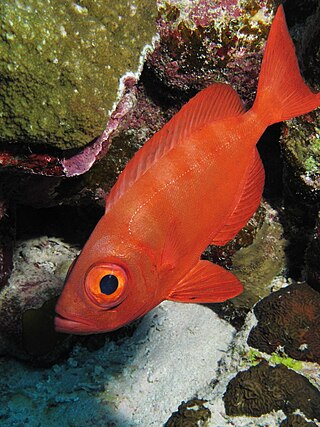
Priacanthus hamrur, the lunar-tailed bigeye, goggle eye, or moontail bullseye, is a species of marine fishes belonging to the family Priacanthidae.

The halavi guitarfish is a part of the Glaucostegidae family. It is a species of ray found in the Indo-West Pacific. Recorded twice, in 1997 and 2004, in the levantine waters, the question of its permanent settlement in the Mediterranean Sea remains open. Its name is derived from the Arabic word حلاوي (halawi).

Rhabdosargus sarba, also known as the goldlined seabream, silver bream, tarwhine, or yellowfin bream, is a species of marine ray-finned fish belonging to the family Sparidae, which includes the seabreams and porgies. This fish has a wide [[Indo-Pacific distribution.

Acanthopagrus berda, the goldsilk seabream, sly bream, picnic seabream, black sea bream, black porgy, picky bream, silver bream or river bream, is a species of ray-finned fish belonging to the family Sparidae, the sea breams and porgies. This species is found in the Indian Ocean.

Leiognathus equula, the common ponyfish is a species of marine ray-finned fish, a ponyfish from the family Leiognathidae. It occurs in brackish and marine waters from East Africa to Fiji in the Indian and western Pacific Oceans, Red Sea and Persian Gulf.

Hemiramphus far, the halfbeak, black-barred halfbeak, black-barred garfish, barred halfbeak, barred garfish or spotted halfbeak, is a schooling marine fish belonging to the family Hemiramphidae, the halfbeaks. It has an Indo-Pacific distribution and has invaded the eastern Mediterranean through the Suez Canal.

Siganus rivulatus, the marbled spinefoot, rivulated rabbitfish or surf parrotfish, is a gregarious, largely herbivorous ray-finned fish of the family Siganidae. Its natural range encompasses the western Indian Ocean and the Red Sea from where it colonised the Mediterranean Sea by Lessepsian migration through the Suez Canal. It is the type species of the genus Siganus.
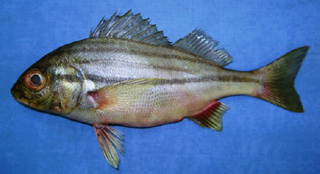
Pomadasys stridens, the striped piggy or lined piggy, is a grunt from the western Indian Ocean and is one of a group of Indo-Pacific marine species which have colonised the Mediterranean Sea through the Suez Canal from the Red Sea, a process known as Lessepsian migration.






















